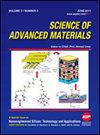Applications of Titanium Dioxide (TiO2) Nanoparticles in Photocatalysis
IF 0.9
4区 材料科学
引用次数: 0
Abstract
Titanium dioxide nanoparticles (TiO2 NPs) are conspicuously preferred as photocatalyst among the transition metal oxide nanoparticles. It exhibited in three polymorphisms of steady state rutile phase while brookite and anatase sustaining in metastable phase. The mixed phases of anatase phase and rarely found brookite phase mostly preferred for the photodegradation applications. The economically affordable along with nontoxic nature on top of excellent opto-electronics and catalytic properties of TiO2 NPs are eminently favorable for the photocatalytic degradation of chemically complex structured numerous organic and inorganic dyes, phenol and phenol-based derivatives, passive microplastics as well as suspended matters, non-biodegradable cytostatic drugs, acetaminophen, pharmaceutical organic waste compounds in addition to water pollutants. The photocatalytic capability of these NPs enhanced by upgrading the structural and morphological nature by opting different synthesis techniques as well preparing the nanocomposites of TiO2 incorporation with other metals. The hydrothermally prepared polymeric membranes of polyvinylidene with TiO2 NPs effectively (more than 90%) removed 17 α–ethinylestradiol from the contaminated water compared to Diclofenac under Uv irradiation. As it fronting the issue of electrostatic repulsion to all other membranes surface. The grafted membrane recorded highest degradation efficiency of 95.4% and best reusability of 90% saturated at fifth recycle for Methylene Blue azo dye compared with blending and dip coating membranes. The TiO2 modified ultrafiltration membranes of Polyvinylidene Fluoride with Dopamine illustrated the 92.6% photocatalytic degradation of Sulfadiazine which is most hazardous and highly resistant to biodegradation. 100% degradation of phenol derivative by TiO2 NPs hybrid polymeric films in visible light irradiation. The degradation efficiency of heterogenous photocatalyst Carbon–TiO2 contained anatase and brookite phased for Methylene Blue dye was 100% while for Rhodamine–B higher than 99% in solar and more than 78% in LED light irradiation. The recent trends for improvisation of photocatalytic ability of TiO2 NPs to enhance the quality of water and hence the mankind are elaborated.二氧化钛 (TiO2) 纳米粒子在光催化中的应用
二氧化钛纳米粒子(TiO2 NPs)是过渡金属氧化物纳米粒子中最理想的光催化剂。它呈现出三种多态性,稳定状态为金红石相,而褐铁矿相和锐钛矿相则维持在易变相。在光降解应用中,锐钛矿相和罕见的褐铁矿相的混合相最受欢迎。TiO2 NPs 经济实惠、无毒,而且具有出色的光电子学和催化特性,非常适合光催化降解化学结构复杂的多种有机和无机染料、苯酚和苯酚基衍生物、被动微塑料以及悬浮物、不可生物降解的细胞抑制药物、对乙酰氨基酚、制药有机废料以及水污染物。通过采用不同的合成技术以及制备二氧化钛与其他金属的纳米复合材料,提高了这些纳米粒子的结构和形态性质,从而增强了它们的光催化能力。与紫外线照射下的双氯芬酸相比,水热法制备的含有 TiO2 NPs 的聚偏二乙烯聚合物膜能有效(90% 以上)去除污染水中的 17 α-炔雌醇。因为它解决了静电排斥所有其他膜表面的问题。与混合膜和浸渍膜相比,接枝膜对亚甲蓝偶氮染料的降解效率最高,达到 95.4%,第五次循环时的饱和度也达到了 90%。用多巴胺改性的二氧化钛聚偏氟乙烯超滤膜对磺胺嘧啶的光催化降解率为 92.6%,而磺胺嘧啶是最有害的物质,对生物降解有很强的抵抗力。在可见光照射下,TiO2 NPs 杂化聚合物薄膜对苯酚衍生物的降解率为 100%。含有锐钛矿和褐铁矿相的异质光催化剂 Carbon-TiO2 对亚甲蓝染料的降解效率为 100%,而在太阳光和 LED 光照射下,对罗丹明-B 的降解效率分别高于 99% 和 78%。本文阐述了提高 TiO2 NPs 光催化能力以改善水质的最新趋势,从而提高人类的生活质量。
本文章由计算机程序翻译,如有差异,请以英文原文为准。
求助全文
约1分钟内获得全文
求助全文
来源期刊

Science of Advanced Materials
NANOSCIENCE & NANOTECHNOLOGY-MATERIALS SCIENCE, MULTIDISCIPLINARY
自引率
11.10%
发文量
98
审稿时长
4.4 months
 求助内容:
求助内容: 应助结果提醒方式:
应助结果提醒方式:


